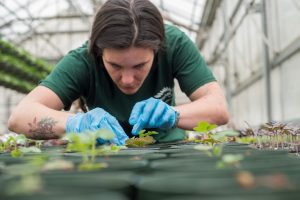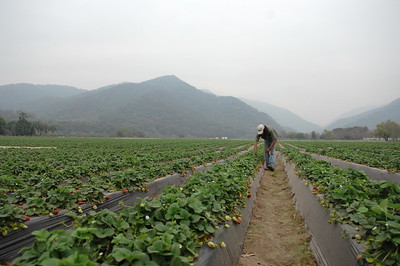1.1 What is horticulture?
Learning objectives
By the end of this section you will be able to:
- Define the term horticulture.
- Describe disciplines related to horticulture.
- Describe some of the specialties in the field of horticulture.

Horticulture and related disciplines
Horticulture
Horticulture is the art and science of the development, sustainable production, marketing, and use of high-value, intensively cultivated food and ornamental plants. The word is derived from the Latin words hortus (garden plant) and cultura (tilling the soil). Horticulture includes ornamental and food plants that are grown with intensive and individualized care, and often in a small space rather than in an expansive field.
Horticultural plants overview |
|
Ornamental plants |
Food plants |
| Flowers, ornamental shrubs, ornamental trees, turfgrass, native grasses, and forbs are all horticultural plants. | The plants producing the vegetables and fruits we eat are all horticultural plants. |
| They all have a fairly high value per acre. | They have a high value per acre and, like the ornamental plants, require intensive management. |
Agronomy
Agronomy is another term commonly used in reference to food production, and refers to the management of plants grown over large areas with less intensive management than that normally provided to garden plants. Its etymology is from the Greek agros (= field) and nomos (~management). Agronomy fields are larger than gardens, so the plants grown in these fields are less intensively and individually managed than those in most gardens. It is estimated that a single agronomy farm produces food for over 150 people.

Extensive agronomic crop production requires fewer person-hours of management per acre than intensive horticultural production, which requires more person-hours of management. In contrast, agronomy refers to management of field crops such as cereals (e.g. corn, wheat, rice, barley) and legumes (e.g. soybeans, common beans, peanuts, alfalfa) and a few other high-acreage crops, like cotton. These are typically plants that have a low dollar value per acre, and in many cases the crops are used for animal feed rather than for direct human consumption. These are grown over extensive areas with less intensive management, or at least with fewer people per acre involved in managing the crop than would be typical of horticultural crops.
Forestry
Forestry is the science or practice of propagating, planting, managing, and caring for forests, and of harvesting products from them. Forestry, which focuses on trees for building materials, pulp, and paper, is a third type of plant-production system, considered separately from horticulture and agronomy, and is not covered in this course.
Agriculture

Agriculture is the science or practice of farming, including cultivating soil for growing crops and rearing animals to provide food, fiber, and other products. The term is derived from the Latin ager (field) and cultura (tilling the soil). While the Latin root means “field” and implies a larger land area than “garden,” “agriculture” typically encompasses both horticulture and agronomy. For instance, the University of Minnesota College of Food, Agricultural and Natural Resource Sciences (UMN CFANS) includes both the Department of Horticultural Science and the Department of Agronomy and Plant Genetics. There is, however, no hard, distinct line separating horticulture and agriculture. While horticulture deals with plants you might find in a garden, it’s common to find those same plants (like vegetables and fruits) grown in large fields and harvested in volumes sufficient to supply grocery stores. Other ornamental garden plants, such as annual and perennial flowers, ornamental shrubs, and trees, are planted in extensive, designed landscapes. Field corn used for animal feed is considered an agricultural crop, while sweet corn is considered a horticultural crop, yet they are the same species of plant.
Here is a summary of terms:
- Horticulture: Requires intensive management on fewer acres and higher human input per acre, and produces a higher value per acre. Includes ornamental plants and whole foods (like those found in the produce aisle).
- Agronomy: Requires extensive production on more acres with lower human input per acre, and produces a lower value per acre. Includes animal feed and processed food ingredients, (such as oil, protein, sugar, and starch).
- Agriculture encompasses both horticulture and agronomy.
Domesticated plants and wild plants
The plants grown in horticulture and agronomy are usually domesticated rather than wild, meaning that humans have selected them, intentionally or unintentionally, for particular characteristics such as adaptation to cultivation in a garden, large showy flowers, or large, sweet fruits. You will learn about the science of plant improvement and domestication in the section on plant breeding.
Because garden plants are grown in modest-sized spaces, the gardener can provide intensive management such as a complex garden design, special care for the soil and plant health, and regular weed control.
In general, then, “horticulture” refers to domesticated ornamental and food plants that humans grow in modest-sized spaces where they provide intensive management.
Horticulture and plant propagation
Science of plants

Plant science explores how a plant is put together and how its parts work together during a plant’s life cycle — from seed to seed.
Throughout this course, you will study plant structure, growth, and reproduction, applying what you learn to plant propagation practices in the lab portion of this course.
Science in our lives
For many of you, this course might be the only science course you take. The course therefore goes beyond the subject of plants to help you to see the world as a scientist might see it. Science is a systematic enterprise that builds and organizes knowledge in the form of testable explanations based on observations and predictions.
You will learn how to propagate plants, and learn about plant structure and function. But perhaps more importantly, you will learn about science as a way of understanding and appreciating the world around you — in this case, the horticultural world around you.
Review questions
- What is the difference in meaning between the Latin words hortus and agros?
- Differentiate among horticulture, agronomy, and agriculture.
- In general, which would you expect to provide the highest value per hour of human management: horticultural plants like vegetables, or agronomic commodity crops like corn?
Horticulture specialties
Within the industry, and also within universities, horticulture is often subdivided into specialties according to the use of the plant or plant part that is produced. Here are six of these specialties:
- Breeding and genetics: development of new cultivars (cultivated varieties) of plants for production via sexual reproduction.
- Floriculture: production and marketing of plants valued for their flowers and propagated by seed or by cuttings.
- Landscape horticulture: production, marketing, and maintenance of plants used in designed and managed landscapes.
- Olericulture: production and marketing of plants or plant parts valued for culinary use as vegetables.
- Pomology: production and marketing of plants or plant parts valued for their culinary use as fruits including nuts.
- Post-harvest management: development of practices that maintain quality and prevent spoilage of harvested horticultural plants or plant parts during storage and transportation.
Review and looking ahead
Plant propagation refers to plant multiplication, or making many plants from just a few. Two broad categories of multiplication will be addressed in this course:
- Asexual reproduction: ausing new plants to arise from plant parts like leaves, stems, or roots, or from storage organs like tubers or rhizomes.
- Sexual reproduction: making new plants from spores or seeds.
Review questions
- Name two or three plants you have eaten in the last few days that are studied in pomology.
- Name two or three plants you have eaten in the last few days that are studied in olericulture.

